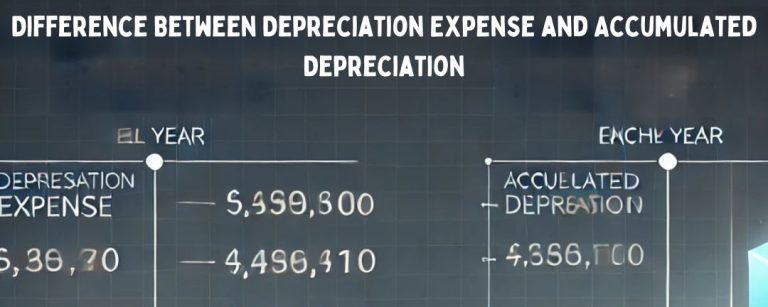The difference between depreciation expense and accumulated depreciation is fundamental to understanding how companies account for the gradual loss of value of their fixed assets over time. Depreciation is a way to allocate the cost of an asset over its useful life, and these two terms represent different aspects of that process. While depreciation expense refers to the periodic cost deducted from a company’s income, accumulated depreciation tracks the total amount of depreciation recorded against an asset since its acquisition. In this article, we will explore both terms in detail, explaining their roles in financial statements, how they are calculated, and their impact on business accounting.
What is Depreciation Expense?
Depreciation expense is the periodic amount that is deducted from a company’s income statement to account for the wear and tear on fixed assets, such as machinery, buildings, and equipment. It is recorded as an expense in the income statement and represents the reduction in the value of the asset as it is used over time. Depreciation expense helps match the cost of an asset to the revenues it helps generate during its useful life.
- Calculation: Depreciation expense is typically calculated using methods such as straight-line depreciation, declining balance method, or units of production method. The most common method used is the straight-line depreciation, where the asset’s cost is spread equally over its estimated useful life.
- Straight-line Method: Depreciation expense = (Cost of Asset – Salvage Value) / Useful Life
- Declining Balance Method: Depreciation expense = (Book Value at Beginning of Year) × Depreciation Rate
- Units of Production Method: Depreciation expense = (Cost of Asset – Salvage Value) / Total Units Expected to be Produced × Units Produced in the Period
- Impact on Profit: Depreciation expense reduces the taxable income of a company because it is considered a non-cash expense. It does not involve actual cash outflow but reduces the reported profit.
- Examples of Depreciation Expense
- If a company purchases machinery for $50,000 with an estimated useful life of 5 years and no salvage value, the annual depreciation expense using the straight-line method would be $10,000 per year.
What is Accumulated Depreciation?
Accumulated depreciation is the total amount of depreciation that has been recorded on an asset up until a particular point in time. It is a contra asset account on the balance sheet, meaning that it offsets the value of the asset it is associated with. Unlike depreciation expense, which is reported on the income statement, accumulated depreciation is reported on the balance sheet and reduces the book value of the asset.
- Cumulative Nature: Accumulated depreciation is a running total of all the depreciation expenses that have been recorded for an asset since it was purchased. As time passes, the accumulated depreciation increases, reflecting the cumulative wear and tear on the asset.
- Presentation on Financial Statements: On the balance sheet, assets are typically listed at their original cost, with accumulated depreciation subtracted to show the asset’s current book value or net book value. This gives a clearer picture of the asset’s remaining value.
- Formula: Book Value of Asset = Original Cost of Asset – Accumulated Depreciation
- Examples of Accumulated Depreciation
- If the machinery mentioned above was purchased for $50,000 and the company has been depreciating it for two years, the accumulated depreciation after two years would be $20,000 (2 years × $10,000 per year).
1. Key Differences Between Depreciation Expense and Accumulated Depreciation
The difference between depreciation expense and accumulated depreciation is significant in terms of their roles in financial accounting. Here’s a comparison to clarify:
| Aspect | Depreciation Expense | Accumulated Depreciation |
| Definition | The amount charged to the income statement each period to reflect the depreciation of an asset. | The cumulative total of all depreciation recorded against an asset since its acquisition. |
| Location in Financial Statements | Appears in the income statement as an expense. | Appears in the balance sheet as a contra asset. |
| Purpose | Reduces taxable income by accounting for the asset’s cost allocation in the current period. | Reduces the book value of the asset to reflect its reduced value. |
| Periodicity | Calculated and recorded each year or period. | Cumulative total over the asset’s life. |
| Effect on Cash Flow | Non-cash expense that reduces taxable income but does not affect cash flow. | No direct impact on cash flow, though it affects the asset’s net book value. |
2. How Depreciation Expense Affects Profit and Taxes?
Depreciation expense is a critical concept for understanding how businesses calculate their profits and taxes. By recording depreciation on assets, companies can lower their taxable income, which reduces their tax liabilities. Since depreciation is a non-cash expense, it doesn’t involve an actual outlay of cash, but it effectively lowers the income on which a business is taxed.
- Tax Benefits: In many tax jurisdictions, businesses are allowed to deduct depreciation from their income taxes. This reduces the taxable income and thus the tax burden, leading to potential cash savings.
- Profitability: Although depreciation expense reduces a company’s reported profit, it doesn’t reflect the actual cash outflow. Thus, a company can still be profitable and generate cash even if depreciation expense is high.
3. How Accumulated Depreciation Affects the Balance Sheet?
Accumulated depreciation plays a crucial role in determining the value of assets on the balance sheet. Over time, as an asset accumulates depreciation, its book value decreases, which reflects its wear and tear. This helps provide a more accurate representation of the asset’s current value, based on its expected remaining life.
- Asset Valuation: Accumulated depreciation ensures that assets are not overvalued on the balance sheet. By reducing the carrying value of assets, businesses can provide more realistic assessments of their worth.
- Impact on Financial Ratios: Accumulated depreciation also impacts various financial ratios, such as the return on assets (ROA) or asset turnover ratio, since these ratios are based on the value of assets.
4. Why Understanding Both is Important for Financial Analysis?
Understanding the difference between depreciation expense and accumulated depreciation is essential for financial analysis and decision-making. For investors, creditors, and management, knowing how depreciation affects both the income statement and the balance sheet is key to assessing the financial health of a business.
- Cash Flow Management: Since depreciation expense reduces taxable income but doesn’t affect cash flow, it is an important consideration for evaluating a company’s cash flow and liquidity.
- Investment Decisions: For investors, understanding how accumulated depreciation affects asset values helps in evaluating the real worth of a company’s fixed assets and its long-term financial stability.
Conclusion
The difference between depreciation expense and accumulated depreciation is fundamental to understanding financial accounting and the reporting of an asset’s value over time. While depreciation expense impacts the income statement by reducing taxable income, accumulated depreciation is recorded on the balance sheet and reflects the cumulative reduction in an asset’s value. Both concepts are essential for businesses to manage their financial reporting and tax obligations effectively. By comprehending these differences, investors, analysts, and business owners can make more informed decisions about a company’s financial health and future prospects.
Difference between Depreciation Expense and Accumulated Depreciation FAQs
What is the main difference between depreciation expense and accumulated depreciation?
The main difference is that depreciation expense is recorded periodically on the income statement, reducing taxable income, while accumulated depreciation is the cumulative total of depreciation deducted from the value of an asset on the balance sheet.
How does depreciation expense affect a company’s profit?
Depreciation expense reduces a company’s profit by allocating the cost of an asset over its useful life. It is a non-cash expense, meaning it lowers taxable income without affecting cash flow.
How is accumulated depreciation shown in financial statements?
Accumulated depreciation is listed on the balance sheet as a contra asset account, which reduces the book value of the asset over time.
Why is depreciation important for tax purposes?
Depreciation reduces taxable income, leading to lower taxes for the company. This provides businesses with tax relief, helping to conserve cash.
Can accumulated depreciation exceed the original cost of an asset?
Can accumulated depreciation exceed the original cost of an asset?


